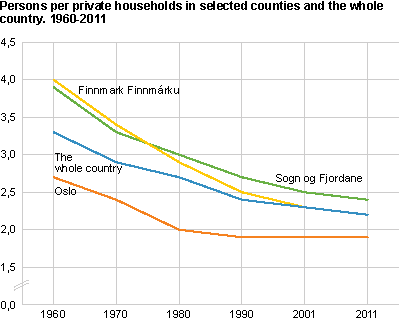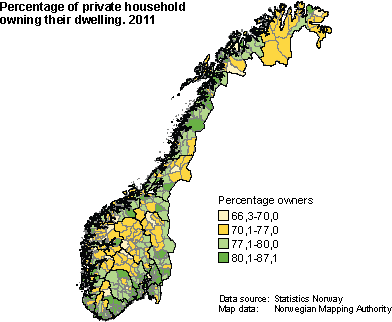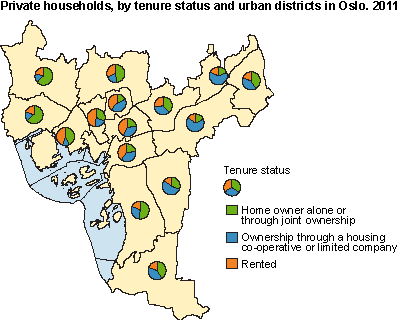Content
Published:
Smaller households in all regions
According to the 2011 population and housing census there were 2 224 000 private households in Norway on census day, 19 November. As much as 40 per cent of all households consisted of one person, and the percentage of one-person households is increasing. At the same time the percentage of households with children is decreasing, so the long term trend moves towards smaller households.
For the first time household figures in a Norwegian census are based on register data only. This means that no information has been collected directly from the households using questionnaires. As in previous censuses, households are defined according to the dwelling household concept. In principle this means that all persons registered on the same residential address shall belong to the same household. However, due to quality problems in the address data it has been necessary to do some adjustments. See information below and About the statistics . Persons can be members of the same dwelling household even if they do not belong to the same family. However, 94 per cent of all households consist of one family only.
More one-person households and fewer households with children
In 2011 18 per cent of all persons in Norway were living alone. This means that 40 per cent of all households consisted of one person, as compared to only just 30 per cent in 1980.
The percentage of households with children is decreasing. In 1980 more than one third of the households had children below 18 years, as compared to a little more than one out of four households in 2011. Especially the percentage of couples with children has decreased, while the percentage of households with lone parents with children has slightly increased. The percentage of households with adult children has also decreased somewhat since 1980, but much less than for households with children below 18 years.
Living alone is most common in central Oslo and in the peripheral regions
The highest portion of one-person households is found in Oslo, 52 per cent. This means that in 2011 28 per cent of the inhabitants of the capital city were living alone. There are however, substantial differences between the urban districts of Oslo. In the inner city more than 60 per cent of the households consisted of one person, while in the suburban district Søndre Nordstrand, only one third were one-person households. Out of 13 other municipalities with more than 45 per cent one-person households, 11 were situated in Northern Norway. Most municipalities with a low percentage of one-person households were situated in the surroundings of the larger cities.
Living alone is most common among young people and among the elderly. In the larger cities, many young people are living alone. In the peripheral regions the high percentage of one-person households is more a result of an aging population.
Smaller households over time
The number of households is more than doubled since the 1960 census. In the same period the population growth is only just 40 per cent. In 1960 the average household size was 3.3 persons. For every decennium households have become smaller, and in 2011 the average size was 2.2 persons. Furthermore, the difference between regions has diminished over the last fifty years. In 1960 the county of Finnmark had the largest households with an average size of 4.0 persons and Oslo the smallest with an average of 2.7 persons. In 2011 Oslo still had the smallest households with an average size of 1.9 persons. All other counties had an average between 2.2 and 2.4 persons.
Three out of four households own their dwelling
In 2011 77 per cent of all households were the owners of their dwelling, approximately the same as in the 2001 census. 62 per cent were homeowners and 15 per cent were owners through housing cooperatives. The portion of owners was highest among couples with children aged 6 to 17 years and among families with adult children, more than 90 per cent. The portion of owners was lowest among lone parents with small children, 46 per cent, and one-person households, 62 per cent. Cooperative ownership was most common among persons living alone.
Less common to own the dwelling in Oslo
The lowest portion of owners is found in Oslo, 69 per cent. In particular, the percentage of homeowners was low in Oslo. One third of the households owned their dwelling through a housing cooperative, well above the national average. Especially in the inner city the percentage of households owning their dwelling was low. Cooperative ownership was much more common in the eastern part of Oslo than in the west, ranging from more than 60 per cent in urban districts in the east to less than 20 per cent in most western districts.
There is a clear connection between type of household and tenure status. In the larger cities the smallest households are found in the central parts, and these are also the districts where owning the dwelling is less common.
Availability of cars less common for persons living alone
Figures from the 2011 census show that 72 per cent of all households in Norway had a private car for their disposal. These figures are based on register data and the percentage is somewhat lower than in statistics based on interviews. According to the 2001 census, 70 per cent of all households had a car available for use.
Less than half of all one-person households had a car for their disposal in 2011. Among households with two or more persons the portion was almost 90 per cent. Having a car available was most common among households where the oldest person is between 45 and 69 years. The lowest portion is found among households where the oldest person is below 25 years, 26 per cent. But also among households where the oldest person is 70 years and above, the portion was less than the average, 61 per cent. The percentage of elderly people having a car available was however much larger in 2011 than in 2001.
Many households without a car in Oslo
In Oslo only half of the households had a car for their disposal. One reason for this is that there are many one-person households in Oslo, but the percentage was below the national average for all types of households. Especially in the central parts of Oslo, there were many households without a car available. Also in other large cities the percentage of households having a car for disposal was below the national average. Furthermore, it was less common to have a car in some costal parts of Western and Northern Norway, especially in municipalities situated on islands without a mainland connection.
Households in the 2011 censusAs in the annual household statistics, the principle in the 2011 census is to use information on residential address from the population register to decide what persons are members of the same household. However, due to quality problems in the address data it has been necessary to develop a method utilizing supplementary data. See About the statistics, 3.5. In this method comparability with the 2001 census has been emphasized. However, in comparing figures from the 2011 census with figures from previous censuses, the difference in data collection and processing methods should be taken into account. More information in About the statistics.
The income statistics for households uses basically the same data as the census, but in the income statistics unmarried students registered as residents with their parent, are counted as residents on the place of study if the distance from the registered address to the place of study is long. Together with some other adjustments, mainly for persons living in institutions, the result is that the number of households in the income statistics is approximately 4 per cent higher than in the census. In the income statistics there are more one-person households and couples without children and fewer households with adult children. More information in About the statistics , 6.2.
In surveys based on interviews, place of actual resident is reported by the respondents themselves and the concept of housekeeping unit is used. Register-based statistics will in general show somewhat larger households, fewer one-person households and fewer cohabiting couples than statistics based on interviews. |
Households having a car for their disposalThe 2011 census statistics on availability of cars is, as the corresponding statistics in the 2001 census, based on registers. All private cars owned by (registered in the name of) household members are counted, as well as cars available through private leasing. Persons liable to tax charge on private use of a company car, is regarded to have one car in addition.
The 2011 census shows that 72 per cent of all household have a car for their disposal. According to surveys bases on interviews the percentage is above 80. The difference between the census and these surveys are larger for Oslo than for the country as a whole. This indicates that these surveys include ways of disposing cars that is not covered by the census. In spite of this estimated under coverage of availability of cars in the census, Statistics Norway finds the figures published to be interesting for users, especially for regional comparisons. For more information in About the statistics , 6.2 |
Tables:
- Table 1 Population, by sex, age and household status. Numbers and per cent. 2011
- Table 2 Private households and persons per private household, by county. 1960, 1970, 1980, 1990, 2001 and 2011
- Table 3 Private households, by type of household. 1980, 1990, 2001 and 2011. Numbers and per cent
- Table 4 Private households, by size of household, county, municipality and urban district. 2011
- Table 5 Private households, by size of household, county, municipality and urban district. 2011 Per cent
- Table 6 Persons in private households, by size of household, county, municipality and urban district. 2011
- Table 7 Persons in private households, by size of household, county, municipality and urban district. 2011. Per cent
- Table 8 Private households, by type of household, county, municipality and urban district. 2011. Per cent
- Table 9 Private households and persons in private households, by size of household and age of the oldest person in the household. 2001 and 2011. Numbers and per cent
- Table 10 Persons in private household, by sex, cohabiting arrangement and age. 2001 and 2011
- Table 11 Persons in private households, by cohabiting arrangements, county, municipality and urban district. 2001 and 2011. Per cent
- Table 12 Private households, by tenure status and type of household. Persons in private households and persons per household, by tenure status. 2001 and 2011. Numbers and per cent
- Table 13 Privat households, by tenure status, county, municipality and urban district. 2001 and 2011. Per cent
- Table 14 Private households, by age of the oldest person, number of children in household and number of cars available for use in the household. 2001 and 2011
- Table 15 Private households by type of household, county, municipality and urban district. Percentage that has a car available. 2001 and 2011.
Additional information
Contact
-
Statistics Norway's Information Centre
E-mail: informasjon@ssb.no
tel.: (+47) 21 09 46 42



